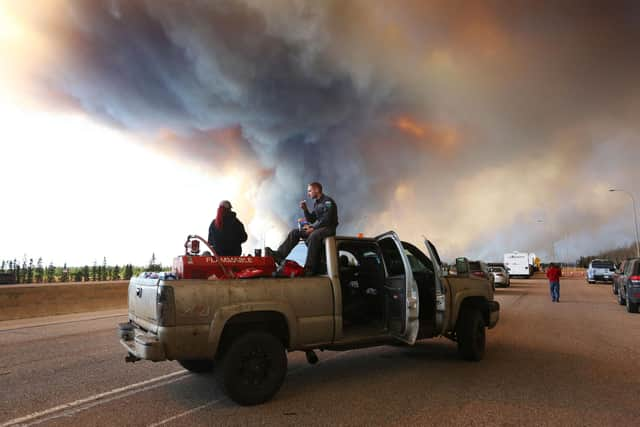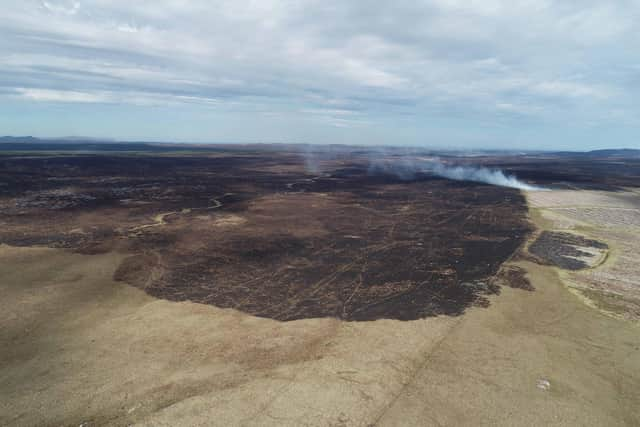Climate change: Wildfires are pushing peatlands towards a terrifying climate change tipping point – Professor Roxane Andersen
This article contains affiliate links. We may earn a small commission on items purchased through this article, but that does not affect our editorial judgement.
In May 2019, I was having a completely ordinary day at my desk in Thurso. It was nice, hot and sunny, but windy. Then I received a worrying email about a large wildfire rapidly advancing towards one of our peatland research sites, within the RSPB’s Forsinard Flows national nature reserve.
This was a bit uncanny. Three years prior to that, in May 2016, one of the Canadian research sites I had been involved in setting up as a post-doctoral student had been ravaged by the Fort McMurray Wildfire, which smouldered for months and affected 590,000 hectares of the boreal landscape. Nicknamed “the Beast”, it ended up being the costliest disaster in Canadian history. In that fire, we lost a research site and equipment worth hundreds of thousands of pounds. My colleagues back then had joked: “This is how one becomes a peatland wildfire scientist: not by design, but by accident.”
Advertisement
Hide AdAdvertisement
Hide AdNow here we were in the Flow Country, with another, admittedly much smaller, wildfire threatening the same kind of equipment, this time powered by highly flammable methanol fuel cells. I dropped everything I was doing and phoned the reserve manager as a precaution to make sure the firefighters were aware of this hazard. I was unprepared for the chaos that would ensue.
The site was burning and the fire was fast approaching our instruments, fuelled by dry vegetation and strong winds, which showed no signs of easing. Someone went to recover the methanol fuel cells while it was still safe to do so. We assembled a team and joined a group of volunteers to prepare a fire break and help where we could, including by monitoring the situation round the clock. Helicopters were brought in to help the fire crew and, eventually, after many days, the fire was deemed to be under control, having burned more than 6,500 hectares of wet heath and bog – by far the largest wildfire in the UK that year. It stopped 50 metres short of our equipment.
Within two weeks of the fire, I had read all the literature I could find on peatland wildfires. With colleagues, we pulled a team together and were successful in applying for a Natural Environment Research Council urgency grant. We then spent two years documenting the aftermath of the fire. That’s how I, too, became an “accidental peatland wildfire scientist”.
And that’s how I ended up in a Zoom meeting in April 2021, talking with a group of Canadian peatland wildfire scientists about what the combination of climate change and peatland degradation meant. Peatlands are super cool – and super good at cooling the climate. Since the retreat of the glaciers after the last Ice Age, they have slowly but steadily been taking up carbon dioxide from the atmosphere to build up plant biomass, which then partially, but not fully, decomposes and builds up layer upon layer of peat.
In doing so, they have stored vast quantities of carbon – more than all the forests of the world combined, despite covering only about three per cent of the land mass. Peatlands are also inherently resilient. This is why they have been around for so long, adapting to short-term changes in climate and recovering from occasional wildfires, droughts or cold spells. A series of complex and fascinating feedback mechanisms underpins that resilience.


The problem is that if those tightly coupled feedback mechanisms are disrupted – by drainage, for example – then a peatland can switch from a long-term carbon sink to a carbon source. Degraded peatlands are also less resilient and more susceptible to other pressures, including wildfires that are associated with rapid carbon losses from combustion.
And this is why we were wondering: if we included emissions associated with wildfires in our current accounting of greenhouse gas emissions from the global northern peatland system, would that have a big impact? And, if we started to include potential impacts of climate change on top of current levels of degradation in this accounting, would we even come close to a tipping point, whereby the whole system, not just any one peatland, would tip from a sink to a source? Perhaps surprisingly, this had never been done before. Given that the wildfire season in Canada is off to a devastating start, it was certainly timely.
Over the course of two years, we collated all the available data on greenhouse gas emissions from pristine, degraded and restored peatlands, peatland wildfire emissions, and the area burned each year, and fed it into a model we created. We then ran a series of scenarios to answer these questions. Our study, recently published in Nature Climate Change, showed that northern peatlands remained a net carbon sink once combustion and post-wildfire emissions are considered, albeit a smaller one.
Advertisement
Hide AdAdvertisement
Hide AdHowever, quite shockingly, we found that the combination of degradation and a changing wildfire regime could push them to increase, rather than mitigate climate change by the end of the century. A future where peatlands can no longer cool the planet is a terrifying prospect. It certainly brings home the sense of urgency that so many other studies have articulated already.


As well as a clear warning, our study did bring a bit of hope, too. We found that rapid restoration of degraded peatland could enhance the current carbon sink effect significantly. Fortunately, we know how to do peatland restoration, and we know that it can work very well. While it is not a silver bullet, we strongly feel that peatland restoration could buy us a bit more time to address the underlying cause of climate change – our dependency on fossil fuels.
Professor Roxane Andersen, Environmental Research Institute, UHI North Highland, University of the Highlands and Islands
Comments
Want to join the conversation? Please or to comment on this article.